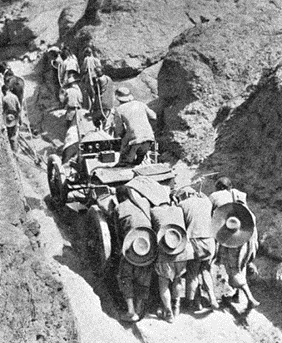After World War II, control of Germany was divided between the four major Allied powers; the U.S., U.K., France, and the Soviet Union. To keep things as confusing as possible, the same was done to Berlin as well, though it was smack dab in the middle of the part controlled by the Soviets. This division resulted in the creation of two very different countries. West Germany was a democratic nation that believed in free speech and capitalism. East Germany was a communist dictatorship which believed in spying on everybody and being just about as paranoid and crazy as a country could possibly be. Things were weird in East Germany. We're talking later finding out all of your friends were members of the secret police assigned to spy on you weird. We're talking the secret police breaking into your home and just moving things around a little bit to convince you that you're going crazy weird. So yeah, just a little weird. As one can imagine, a lot of people didn't really want to live in such a society, and as a result, thousands began to flee to West Germany, with the route through divided Berlin being the easiest. Many of these were East Germany's best and brightest, so to stop the flow, East Germany built a wall across Berlin in 1961. On the east side, the wall was a formidable structure of concrete, barbed wire, and watch towers. On the west, it was a handy thing to cover in graffiti.
Fast forward 28 years to 1989. In a desperate attempt to hold onto power and stave off economic collapse, many communist nations were creating liberal reforms easing all sorts of restrictions that had been in place for generations. However, East Germany was not one of these. No, if anything East Germany doubled down, placing even more restrictions on its people. Unfortunately, East Germany was not an island. In the summer of that year, the communist nation of Hungary opened its border with the west. Soon after, thousands of East Germans flooded into Hungary to escape. East Germany responded by barring travel to Hungary. This sparked nationwide protests that made the crazy old men running the country decidedly nervous. Then Czechoslovakia opened its border. Tens of thousands of East Germans flooded into Czechoslovakia, pissing off not just the government of East Germany, but also the government of Czechoslovakia, and creating a lot of tension between the two countries.
With protests spreading across East Germany, the crazy old men who ran it deposed their leader, a guy named Erich Honecker, who was by the far the craziest of them all, and started implementing reforms. The most important of these was the decision to open the border, allowing people to go to West Germany and West Berlin with just a stamp on some official looking papers. However, rather than make this announcement themselves, they instead had a lower level flunky do it. This flunky was handed a hastily scrawled note with his instructions. The date was November 9. The flunky was supposed to announce that the border would be opened the next day, but instead, announced that it would open immediately. This resulted in tens of thousands of East Germans flooding to the security checkpoints along the Berlin Wall, demanding to be let out, which thoroughly confused the border guards, who had not yet been given any orders regarding the change in policy.
The border guards quickly became nervous as the crowds continued to grow. Desperate, they began phoning their superiors for orders. One of these was Harald Jaeger. As people first started to arrive, Harald called his superior and asked for orders, at which time he was told to fuck off and do his job. As the crowd grew larger and more unruly, Harald called again. This time his superior called him a coward who was probably lying about what was going on for god only knows what reason. Fun fact, people who work for a police state rarely trust anybody for some reason. Anyways, after a few more such phone calls, Harald finally decided fuck this shit, and just opened the checkpoint and let anyone go across. Thousands of East German's flooded into West Berlin. Hearing about it, the guards at the other security checkpoints opened their gates as well. For their part, West Germans rushed to greet the East Germans, bringing champagne and flowers. The whole length of the wall erupted into a giant party that lasted for days.
Things just kind of snowballed from there. People began to hack away at the wall, causing whole sections to fall. The East German government at first tried to stop them, but after a while gave up and just let it happen. To encourage travel, the West German government handed out money to any East German that crossed so that they could buy some shit to take home. Several famous musicians flocked to the wall to sing about freedom, the most famous being David Hasselhoff, who sang to 500,000 Germans from atop the wall on New Years Eve while wearing a leather jacket covered in flashing lights. Seeing that they couldn't stop people from tearing down the wall, the East German government began pretending it had been their idea all along, completely dismantling it in June of 1990. In July of that year, East Germany formally adopted West German currency, making it easier for people to buy shit, and in October the two countries were officially reunified.
Image: https://commons.wikimedia.org/wiki/File:Berlin_1989,_Fall_der_Mauer,_Chute_du_mur_08.jpg



